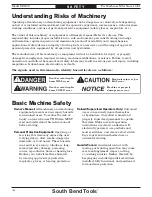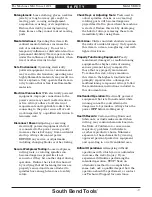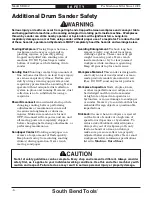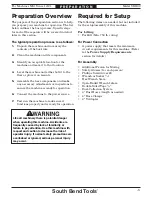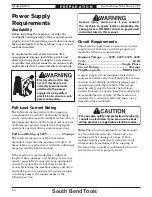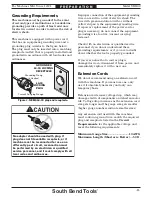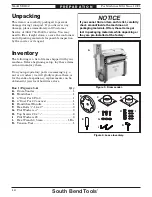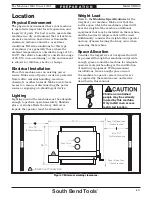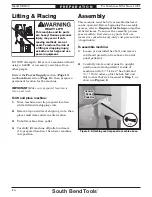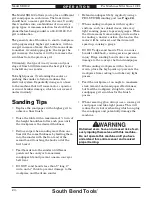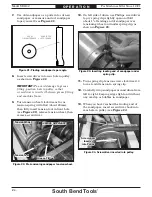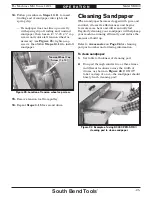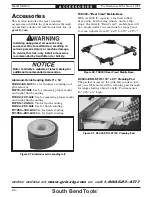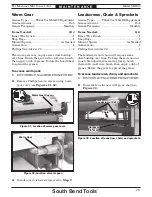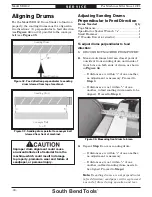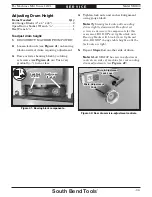
South Bend Tools
For Machines Mfd. Since 12/21
Model SB1102
-19-
O P E R A T I O N
Stock Inspection &
Requirements
Some workpieces are not safe to sand, or they
may require further preparation before they can
be safely sanded without increasing risk of injury
to the operator or damaging the sanding belt or
the sander.
Before sanding, inspect all workpieces for the
following:
•
Material Type:
This machine is intended
for sanding natural and man-made wood
products, and laminate-covered wood
products. This machine is NOT designed
to sand glass, stone, tile, plastics, drywall,
cementious backer board, metal, etc.
Sanding metal objects can increase the risk
of fire. Sanding improper materials increases
the risk of respiratory harm to the operator
and bystanders due to the especially fine
dust inherently created by all types of
sanding operations—even if a dust collector
is used. Additionally, the life of the machine
and sanding belts may be greatly reduced
(or immediately damaged) from sanding
improper materials.
•
Foreign Objects:
Tramp metal, nails, staples,
dirt, rocks and other foreign objects are often
embedded in wood. While sanding, these
objects can become dislodged and tear the
sanding belt. Always visually inspect your
workpiece for these items. If they can't be
removed, DO NOT sand the workpiece.
•
Wet or "Green" Stock:
Sanding wood
with a moisture content over 20% causes
unnecessary clogging and wear on the
sanding belt, increases the risk of kickback,
and yields poor results.
•
Excessive Warping:
Workpieces with
excessive cupping, bowing, or twisting
are dangerous to sand because they are
unstable and often unpredictable when being
sanded. DO NOT use workpieces with these
characteristics!
•
Excessive Glue or Finish:
Sanding
workpieces with excess glue or finish will
load up the abrasive, reducing its usefulness
and lifespan.
•
Minimum Stock Dimensions:
DO NOT sand
boards less than 9" long, 2" wide, and
1
⁄
8
"
thick to prevent damage to the workpiece
and to reduce the risk of your hands
contacting the abrasive belt (see Figure 14).
Figure
Figure 14. Minimum dimensions for sanding.
. Minimum dimensions for sanding.
9" Min.
1
/
8
" Min.
2" Min.
Choosing Sandpaper
There are many types of sandpaper rolls to
choose from. We recommend Aluminum Oxide for
general workshop environments. Below is a chart
that groups abrasives into different classes, and
shows which grits fall into each class.
Grit
Class
Usage
36
Extra
Coarse
Rough sawn boards,
thickness sanding,
and glue removal.
60
Coarse
Thickness sanding
and glue removal.
80–100
Medium
Removing planer
marks and initial
finish sanding.
120–180 Fine
Finish sanding.
Choosing Sandpaper
This machine comes from the factory with 80 grit
installed on the front drum and 120 grit on the
rear.
suitable workpiece


